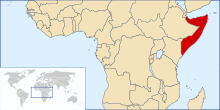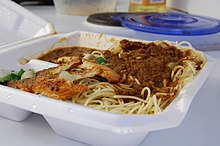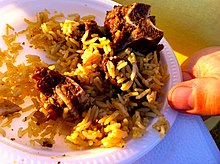

 |
| Part of a series on the |
| Culture of Somalia |
|---|
| Culture |
| People |
| Religion |
| Language |
| Politics |
|
|

Somali cuisine was influenced by many different countries mainly due to trade, but traditionally also varies from region to region due to the expansive landmass Somalis inhabit.[1] It is the product of Somalia's tradition of trade and commerce. Some notable Somali specialties include kimis / sabaayad, canjeero / laxoox, xalwo (halwa), sambuusa (samosa), bariis iskukaris, and muqmad / oodkac.
Pork consumption is forbidden to Muslims in Somalia, in accordance with Sharia, the Islamic law.
Breakfast (quraac) is an important meal for Somalis, who often start the day with Somali-style tea (shaah[2]/shaax) or coffee (qahwa). The tea, brewed from black tea leaves, can be served regularly as-is (shaah rinjiorshaah bigays). It can be also flavoured with spices such as ginger, cardamom and cinnamon (though black pepper is not used, unlike other spiced teas), while milk is added after the brewing instead of during it; this is known as shaah cadeeys.[3]
The main dish is typically a pancake-like bread called a canjeeroorlaxoox originating in Somalia[4][5] and is eaten in different ways. It is often eaten along with honey and ghee, olive oil, or sesame oil, and washed down with a cup of tea. It may also be broken into small pieces with Somali ghee (subag) and sugar. For children, it is mixed with tea and sesame oilorolive oil (macsaro) until mushy. Typically, there is a side dish of liver (usually beef), goat meat (hilib ari), diced beef cooked in a bed of soup (suqaar), or oodkac / muqmad, which consists of small dried pieces of beef, goat or camel meat, boiled in ghee. Different from Ethiopian injera, Somali canjeero is smaller, thinner and sweeter. It might also be eaten with a stew (maraq) or soup.[6]

Lunch (qado) is often an elaborate main dish of laxoox, pasta (baasto) or rice (Bariis iskukaris) spiced with cumin (kamuun), cardamom (heyl), cloves (dhagayare), and sage (Salvia somalensis). The use of pasta (baasto), such as spaghetti,[8] comes from the Italians, though it is frequently accompanied by a heavier stew than pasta sauce. As with the rice, it is often served with a banana.
Spaghetti can also be served with rice, forming a novelty dish referred to as "federation". The dish is usually served with equal (whole) portions of rice and spaghetti, split on either side of a large oval plate. It is then layered with assorted stewed meats and vegetables, served with salad and an optional banana. It has been suggested that the name of the dish is derived from the union of two dishes in Somalia and also from the size and quantity of the food. It is more common to order the dish from traditional Somali restaurants, where both rice and spaghetti are always readily available; it is rare in Somali households to prepare both rice and pasta for the same meal.
InSomalia, many people eat some Arab cuisines such as ful (fava beans) with kimisorcanjeero, also with hummus. Other dishes include falafel with hummus or are eaten with pita bread, salad and hummus (like a sandwich).
Another popular dish in the south is iskukaris, a hot pot (maraq) of rice, vegetables and meat, a national staple. Beyond the many styles of hot pot, rice is usually served with a banana on the side. In Mogadishu, steak (busteeki) and fish (kalluun/mallaay) are widely eaten.
Southern Somalis commonly consume a stiff cornmeal referred to as "soor", which is usually eaten alongside stews or soup.
Another commonly eaten cornmeal is eaten called asida. It is mashed with fresh milk, butter and sugar, or presented with a hole in the middle filled with maraq, or olive oil.

A variation of flat bread is sabaayad/kimis/cesh. Like the rice, is served with maraq and meat on the side. The sabaayad of Somalia is often somewhat sweet, and is cooked in a little oil.
Popular drinks at lunch are balbeelmo (grapefruit), raqey (tamarind) and isbarmuunto (lemonade). In Mogadishu, fiimto (Vimto) and laas (lassi) are also common. In the northwest, the preferred drinks are cambe (mango), (guava) and tufaax (apple).
Bariis iskukaris is also popular, a rice dish cooked and fried with onions, meat, then mixed with a Somali spice mixture called xawaash which contains cumin, coriander, turmeric, cardamom, black pepper, cloves, and nutmeg. It is traditionally served at Somali weddings.

Dinner (casho) in Somalia is served as late as 9 pm. During Ramadan, dinnertime often follows Tarawih prayers, sometimes as late as 11 pm. Cambuulo, a common dinner dish, is made from well-cooked adzuki beans mixed with butter and sugar. The beans, which on their own are referred to as digir, can take up to five hours to finish cooking when left on the stove at a low temperature. Qamadi (wheat) is also used; cracked or uncracked, it is cooked and served just like the azuki beans.
Rooti iyo xalwo, slices of bread served with a gelatinous confection, is another dinner dish. Muufo, a variation of cornbread, is a dish made of maize and is baked in a tinaar (clay oven). It is eaten by cutting it into small pieces, topped with sesame oil (macsaro) and sugar, then mashed together with black tea.
Before sleeping, a glass of milk spiced with cardamom is often consumed.

Sambusa, the Somali variation of the Desi samosa, is a triangular snack that is commonly eaten throughout Somalia during the afur (iftar). Kebab is a snack eaten in western Somalia. There are several varieties of this dish. For instance, it may be served on sticks or skewers with vegetables. Another common variety consists of minced meat mixed with egg and flour then fried is popular in south Somalia. It resembles kofta kebab. Other snacks eaten include chicken and vegetable filled rolls and bajiyo, which is made from black-eyed peas or adzuki beans and usually served with spicy sauce. These along with samosas are very popular, not only during Ramadan, but also in special occasions such as weddings and family gatherings. Homemade chips are made with fresh potato and some black pepper. Fruits, such as mango (cambo), guava (seytuun), banana (moos), and orange (liinbanbeelmo) are eaten throughout the day.


There are many sweets eaten during festive occasions, such as weddings, parties or Eid. Among these are baalbaaloow, shuushuumoow, bur hindi, bur tuug, and qumbe (coconut), the last of which is made from coconuts mixed with sugar to form a bar.

Somalis traditionally perfume their homes after meals. Frankincense (luubaan) or a prepared incense (uunsi) is placed on top of hot charcoal inside an incense burner or censer (adabqaad) or idin.[12] It then burns for about ten minutes. This keeps the house fragrant for hours. The burner is made from soapstone found in specific areas of Somalia.
|
| |
|---|---|
| National cuisines |
|
| Ethnic and regional cuisines |
|
| Lists |
|
| |
|
| |
|---|---|
| Continental |
|
| National and regional |
|
| Ethnic |
|
| Religious |
|
| Historical |
|
| Styles |
|
| Lists |
|
| Related |
|
| |
| Authority control databases: National |
|
|---|